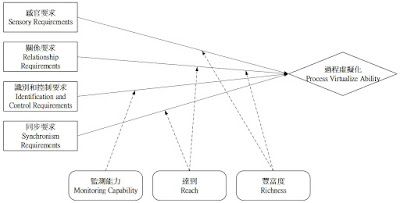本期為大家介紹在社會等領域廣泛應用的理論模型——過程虛擬化理論(Process virtualization theory)。
什麼是過程虛擬化理論?
“過程虛擬化理論”的目的是為這個問題提供一個一般的理論基礎。過程虛擬化理論包括四個主要維度(感官要求、關係要求、同步要求以及識別和控制要求),它們影響推動虛擬化過程是否可行。
過程虛擬化理論認知到資訊技術扮演過程虛擬化的關鍵因素,考慮三個變數-監控能力、達到和豐富性作為調節變數,明確了資訊技術在過程虛擬化中的理論意義。這有助於解釋資訊技術的進步如何使虛擬的過程得以實現。
模型圖:
模型變數:
1.
自變數:感官要求、關係要求、識別和控制要求、同步要求。
2.
干擾變數:監測能力、達到、豐富度。
3.
依變數:過程虛擬化。
模型出處
Overby, E. M. (2008). Process
Virtualization Theory and the Impact of Information Technology. Organization Science, 19(2), 277-291.
過程虛擬化理論認為一個人做出某種行為受到以下要素影響:
◆感官要求(Sensory Requirements)
定義:身體感官被外界事物刺激的需要
EX: 3D互動看屋可以滿足我視覺上的需求。
◆關係要求(Relationship Requirements)
定義:人們在生活過程中所需要的社會關係
EX: 3D互動看屋可以讓我分享給家人。
◆識別和控制要求(Identification and Control Requirements)
定義:對有關事實或問題進行分類和定性與監督和糾偏的過程
EX: 3D互動看屋可以讓我清楚的知道不同屋況的差異性。
◆同步要求(Synchronism Requirements)
定義:人與機器的互動保持一定的相對關係
EX: 3D互動看屋可以讓我隨時隨地了解房屋的近況。
◆過程虛擬化(Process Virtualize ability)
定義:將事物發展所經過的各種實體過程轉為虛擬程式
EX: 3D互動看屋可以將實體的房屋轉化為3D互動。
◆監測能力(Monitoring Capability)
定義:對某種事物品質因素的代表值測定能力
EX: 3D互動看屋對房子的鑑定能力。
◆達到(Reach)
定義:實現一個目標的努力
EX: 3D互動看屋是技術可以實現的程度。
◆豐富度(Richness)
定義:資訊轉移時所包含的內容多寡
EX: 3D互動看屋包含的內容豐富多元。
文章推薦
本期,為大家推薦2篇應用過程虛擬化理論的英文論文,觸類旁通,總有一篇啟發你的學術靈感!
Process
virtualization theory and the impact of information technology
Overby, E. (2008).
Organization Science, 19(2), 277-291.
Keywords: virtual; virtualization;
process; theory construction; information systems; information technology;
online; electronic commerce; distance learning; relationship development;
banking; ATM
Abstract
In our
increasingly virtual society, more and more processes that have traditionally
been conducted via physical mechanisms are being conducted virtually. This
phenomenon of “process virtualization” is happening in many
contexts, including formal education (via distance learning), shopping (via
electronic commerce), and friendship development (via social networking sites
and virtual worlds). However, some processes are more amenable to
virtualization than others. For example, distance learning seems to work better
for some educational processes than others, and electronic commerce has worked
well for some shopping processes but not for others. These observations
motivate the central question posed in this paper: What factors affect the “virtualizability” of a process? This
question is becoming increasingly important as advances in information
technology create the potential for society to virtualize more and more
processes. To provide a general theoretical basis for investigating this
question, this paper proposes “process virtualization
theory,” which includes four main constructs (sensory
requirements, relationship requirements, synchronism requirements, and
identification and control requirements) that affect whether a process is
amenable or resistant to being conducted virtually. Recognizing that processes
can be virtualized with or without the use of information technology, this
paper makes explicit the theoretical significance of information technology in
process virtualization by discussing the moderating effects of representation, reach,
and monitoring capability. This helps explain how advances in information
technology are enabling a new generation of virtual processes.
“Virtual Or Material, What Do You Prefer?” A Study
Of Process Virtualization Theory
Balci, B. & Rosenkranz, C.
(2014)
Keywords: Process Virtualization
Theory, PVT, Process Characteristics, Process Use, Process Virtualizability.
Abstract
Process
virtualization is receiving increasing attention as an emerging phenomenon in
information systems. Process Virtualization Theory (PVT) has been suggested as
one way for understanding factors that affect the behavior of process
participants when they face a virtual process. In this paper, we empirically
analyze and test the propositions of PVT. We investigate the “airport
check-in” process as our process of interest and
conduct in-depth interviews with 18 informants who use different types of
check-in processes, ranging from completely virtual to completely manual and
material options. We examine why different process participants use or do not use
this process in a virtual environment, and why different types of people
perceive a virtualized process as useful or usable. The findings from most
participants corroborate PVT and show that perceived process characteristics
indeed play a very important role for process virtualizability. However, we
also found a very interesting counter-example in the data, which indicates that
factors such as prior experience and participant characteristics may be equally
or even more important.


沒有留言:
張貼留言